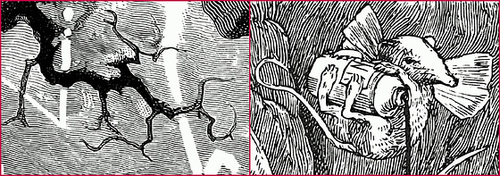Darwins snarked Study
Heads by Henry Holiday and Marcus Gheeraerts the E…
The removed "error" had a purpose
The Flaw was no Flaw
Mary's and the Baker's Kerchiefs
Schnarkverschlimmbesserung
Nose is a Nose is a Nose
Dream Snarks
The Billiard Marker & Henry George Liddell
White Spot
Two Bone Players
The Bankers Fate
So great was his fright that his waistcoat turned…
Wood Shavings turned Pope
Carpenters Shop and Millais' Allusions
The Uncle over Darwin's Fireplace
Holiday - Millais - Anonymous - Galle; detail
Tnetopinmo
The Vanishing and the Gneiss Rock
Nosemorph
Thomas Cranmer's Burning
Lacing Pillow
The Bellman and Sir Henry Lee (no marks)
Wood Shavings turned Pope (1st version)
Darwin's Fireplace and the Baker's Dear Uncle
Henry George Liddell in "The Hunting of the Snark"
Snarked: Henry George Liddell
Holiday - Millais- Anonymous - Galle, detail
Holiday and Gheeraerts I
The Carpenter and Ahasuerus
From Doré's Root to Holiday's Rat
42 Boxes meet the Iconoclasts
Thumb & Lappet
Bonnet Head
Billiard-Marker & Henry George Liddell
Snark Hunt: Square One
Hidden Carrol
"But if ever I meet with a Boojum, that day, I sha…
The Snark in your Dreams
The Butcher and Benjamin Jowett
Ditchley Snark
Ditchley Snark
While he rattled a couple of bones
While he rattled a couple of bones
Anne I?
Tree of Life
The Bellman and Father Time
Snark Hunting with the HMS Beagle
Inspiration by Reinterpretation
The Bellman and Sir Henry Lee
Star and Tail
Darwin's Study and the Baker's Uncle
Kerchiefs and other shapes
Holiday - Millais - Anonymous - Galle
From Doré's Root to Holiday's Rat
Anne Hale Mrs. Hoskins
Anne Hale Mrs. Hoskins
42 Boxes, Sheep, Iconoclasm
Thomas Cranmer's 42 Boxes
With yellow kid gloves and a ruff
The Bandersnatch fled as the others appeared
Millais, Anonymous, Galle
An Expedition Team
Holiday - Millais - Anonymous - Galle
Holiday - Millais- Anonymous - Galle, detail
Holiday and Gheeraerts I
Doré (1863), Holiday (1876), Doré (1866)
See also...
Keywords
- Keyboard shortcuts:
Jump to top
RSS feed- Latest comments - Subscribe to the comment feeds of this photo
- ipernity © 2007-2024
- Help & Contact
|
Club news
|
About ipernity
|
History |
ipernity Club & Prices |
Guide of good conduct
Donate | Group guidelines | Privacy policy | Terms of use | Statutes | In memoria -
Facebook
Twitter




"21 février 2011 à 21 h 47 min
Cette semaine, nous avons mis en ligne dans la Factory les contributions d’un nouveau membre de la communauté artsciencefactory, Goetz Kluge. La recherche proposée par M. Kluge porte sur la réutilisation de formes visuelles dans un autre contexte que celui par lequel elles ont été créées. Cette recherche est menée d’une manière qui s’appuie d’abord sur la sensibilité, elle ouvre de nombreuses perspectives quant à la compréhension de la construction des représentations. Plus d’un siècle avant qu’on ait pour la première fois entendu parler de copié/collé ou de remix, un dessinateur, Henry Holiday, met en oeuvre un système très sophistiqué de citations visuelles pour produire ses propres oeuvres, qui n’ont rien de plagiats ou d’imitations. Il n’est ni le premier ni le seul, mais l’observation attentive de Goetz Kluge, et son utilisation d’outils informatiques récents, aident à comprendre « de quoi sont faites les images » – plastiquement, mais aussi mentalement. Une telle démarche intéresse non seulement les artistes mais aussi tous ceux qui ont à produire des représentations, des visualisations et utilisent pour cela un « vocabulaire » et une « grammaire », le plus souvent sans en être conscients. JMF"
www.snrk.de/le_petit_bleu_qui_trouble
·
Due to the conceptual changes from artsciencfactory.fr to artsciencfactory.com, I don't maintain my artsciencfactory blog anymore.
Above them all th' Arch Angel: but his face [ 600 ]
Deep scars of Thunder had intrencht, and care
Sat on his faded cheek, but under Browes
Of dauntless courage, and considerate Pride
Waiting revenge: cruel his eye, but cast
Signs of remorse and passion to behold [ 605 ]
The fellows of his crime, the followers rather
(Far other once beheld in bliss) condemn'd
For ever now to have thir lot in pain,
Millions of Spirits for his fault amerc't
Of Heav'n, and from Eternal Splendors flung [ 610 ]
For his revolt, yet faithfull how they stood,
Thir Glory witherd. As when Heavens Fire
Hath scath'd the Forrest Oaks, or Mountain Pines,
With singed top thir stately growth though bare
Stands on the blasted Heath. He now prepar'd [ 615 ]
To speak; whereat thir doubl'd Ranks they bend
From wing to wing, and half enclose him round
With all his Peers: attention held them mute.
Thrice he assayd, and thrice in spight of scorn,
Tears such as Angels weep, burst forth: at last [ 620 ]
Words interwove with sighs found out thir way.
Paradise Lost (from Book I), John Milton, 1674
www.dartmouth.edu/~milton/reading_room/pl/book_1/index.shtml
Sign-in to write a comment.